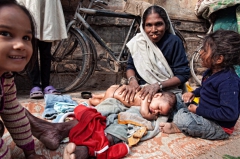02/16/2015
Babies made-in-India - 8. Massage, bath & Breastfeeding
 Once back home, almost everywhere in India, professionals called maalishwali come home to give massage and bath to mothers and infants.
Once back home, almost everywhere in India, professionals called maalishwali come home to give massage and bath to mothers and infants.
And this technique is somehow spreading in the West, with an interesting twist: the parents massage the baby themselves. It is a good to create a bond, while developing the motor skills of the child. The problem with this ‘twist’ is that the mother rarely gets her massage, unless the father is really available (and talented)! Be careful in cold western environment though ;)
For the mother, the idea is that massaging helps the inside organs to get back in place and shape. Paradoxically the re-education of the perineum is not even addressed by the Gynec! Finally, when I asked her,she told me to do some Kegel exercises at home. (I must add that my British midwife has also never heard of the type of perineum re-education prescribed by doctors and performed by physiotherapists in France.)
For the baby's bath, the masseuse sits on the floor with her leg stretched on which the infant lies. Less water wastage, less dangerous than a bucket which can fall of the table and from which the infant can swallow water (especially when he is slippery after a good massage!) but also less fun than a bathtub where he can turn and splash!
As for breastfeeding, beware! You shouldn’t say you are thinking it over! Indians can not understand, for example, that only 56% of French mothers or 69% of British ones breastfeed.
So even if the World Health Organization and UNICEF recommend to “initiate breastfeeding within one hour following birth; practice exclusive breastfeeding during the first six months; and continue breastfeeding for two years and beyond, while starting from the age of six months a supplementary feeding [...]”, it always sound weird to hear a woman say that she is breastfeeding her 4 year old...And it is not uncommon here...
And now, I am done! Be happy that I have spoken only about the most widespread traditions! And not of the custom of eating the placenta for its hormones (which would be better assimilated if the placenta was consumed raw) and to reduce stress. Or of mothers giving girls “joyous genital tickling” and boys “full-on fellatio” (which for these people is not a sexual practice whereas kissing, even the cheek is…). I must say that these traditions are actually mostly Chinese but still present in some parts of India!
Sources: http://www.lllfrance.org/Autres-textes-LLL/Epidemiologie-de-l-allaitement-Allaitement-et-contraception.html ; http://www.unicef.org/french/nutrition/index_24824.html; http://listverse.com/2014/05/03/10-weirdest-birth-customs-from-around-the-world/
(The End)
08:00 Posted in Expatriation (in India and in other countries), Incredible India!, Little Samourai, My stories in India | Permalink | Comments (0) | Tags: india, birth, water birth, pregnancy, baby, infant, newborn, delivery, midwife, swaddling, swaddle, diaper, breastfeeding, hospital, fertility, contraception, sterilization | ![]() Facebook | |
Facebook | |
02/14/2015
Babies made-in-India - 7. The swaddle and the diaper
 Another tradition going on strong is swaddling infants. The benefits are the creation of a sense of security for the baby (it reminds him the uterus), and comfort as it helps him control the reflex-movements that can bother him. For the mother, it's more convenient to carry the kid, a small quiet package. As a result, in India, infants are swaddled most of the time up to three months. On top of above mentioned advantages, it is also believed that it will enable the legs to grow straight. And the hip problems that can be created are royally ignored.
Another tradition going on strong is swaddling infants. The benefits are the creation of a sense of security for the baby (it reminds him the uterus), and comfort as it helps him control the reflex-movements that can bother him. For the mother, it's more convenient to carry the kid, a small quiet package. As a result, in India, infants are swaddled most of the time up to three months. On top of above mentioned advantages, it is also believed that it will enable the legs to grow straight. And the hip problems that can be created are royally ignored.
Since swaddling can indeed be reassuring and appeasing for some infants, you can choose an intermediate solution, like swaddling the baby only during sleep time – it is also interesting to know that this practice after being out-of-fashion in the past decades in the West is now doing its come-back (6).
If you decide to leave the baby legs free when he is not sleeping, then you must be ready, when you enter a hotel carrying your newborn 'monkey-style' to face the outraged looks of doormen, or even their comments: "you should not wear him like that! Poor thing! His legs!!”. Or to bear with the salesguy of Benetton who is likely to get offended and say so out loud, repeatedly, because you should not use a carrier during the first six months...
 To get back to the topic of swaddling, I imagine that this practice goes hand in hand with the use of the Indian cotton nappy. Which is like a piece of cloth with a thread that you fill with other pieces of cloth. The advantages of this diaper is that it is softer for the
To get back to the topic of swaddling, I imagine that this practice goes hand in hand with the use of the Indian cotton nappy. Which is like a piece of cloth with a thread that you fill with other pieces of cloth. The advantages of this diaper is that it is softer for the  butt of the child, cheaper and more eco-friendly (but I am not so sure because you need to do a lot of washing), and the child gets potty-trained faster since he quickly gets tired of having his ass wet all the time. Well, I tried several times at the hospital but I can’t help it, I don’t understand how poop and pee don’t spread everywhere on the child and about everywhere else! Maybe it works better if the baby is kept tightly wrapped (hence moving less)?
butt of the child, cheaper and more eco-friendly (but I am not so sure because you need to do a lot of washing), and the child gets potty-trained faster since he quickly gets tired of having his ass wet all the time. Well, I tried several times at the hospital but I can’t help it, I don’t understand how poop and pee don’t spread everywhere on the child and about everywhere else! Maybe it works better if the baby is kept tightly wrapped (hence moving less)?
Anyway, the only cheap and eco-friendly solution is to leave the baby barebutt... A solution still preferred in the countryside where kids are left very early to deal with themselves or at the signal where babies make people feel bad and more inclined to depart with a coin (hence some business of baby trafficking, cf this post)...
(6) “Nine out of 10 infants in north America are now swaddled in the first six months of life. Sales of swaddling clothes increased in the UK by 61% between 2010 and 2011.” (Source: http://www.theguardian.com/society/2013/oct/28/swaddling-babies-blankets-hip-problems-doctors-warn)
(To be continued...)
08:00 Posted in Expatriation (in India and in other countries), Incredible India!, Little Samourai, My stories in India | Permalink | Comments (0) | Tags: india, birth, water birth, pregnancy, baby, infant, newborn, delivery, midwife, swaddling, swaddle, diaper, breastfeeding, hospital, fertility, contraception, sterilization | ![]() Facebook | |
Facebook | |
02/10/2015
Babies made-in-India - 5. Versus French ways
 Since there is nothing wrong in getting pampered, these customs of returning to the maternal fold, staying at home and keeping bed rest persist through the ages and social classes. Several times I have asked colleagues, newly elevated to the rank of fathers, if they were not too tired. And got the reply “no no, you know, my wife and baby are at my in-laws, they’ll come back only after three months!".
Since there is nothing wrong in getting pampered, these customs of returning to the maternal fold, staying at home and keeping bed rest persist through the ages and social classes. Several times I have asked colleagues, newly elevated to the rank of fathers, if they were not too tired. And got the reply “no no, you know, my wife and baby are at my in-laws, they’ll come back only after three months!".
New French mothers don’t have this luxury of a ‘safety period’ (although apparently (according to Tracy Hogg) British ones do, for 40 days as well) and they soon have to do everything alone: cooking, cleaning, shopping, etc, in addition to taking care of the newborn. That is what I tried to explain to my Indian circle: being an independent businesswoman and daughter of an independent businesswoman, I was genetically programmed (except for medical complication) to get on my feet very fast. And on top of that, with the 'services' we avail in India, i.e. maids, home delivery from shops and restaurants, it is even more manageable than in the West…
As for childbirth, fathers traditionally don't attend, as it was the case till the fifties in the West, where the necessity and benefits of the man's presence are still debated (but at least the choice is open). So in India, you usually have your mother or mother-in-law in the labor room...
After the delivery, help is generally required as some hospitals don't even serve food. So, my mother-in-law kindly offered to stay with us at night in the hospital (4)... As tradition has it, it was her role to get up at night when the baby would cry; not mine, nor her son’s or the nurses’. To pass me the child for me to feed him. Well, to be precise, it was the role of my mother, who was with us but obviously not keen to sacrifice her sleep! My mother must have seemed quite irresponsible by spending more time dragging her counterpart to shopping sprees every day rather than squatting our hospital room! In fact she was doing her job as the mother of the Samurai, meaning she ensured that the three of us would get some privacy all three of us… (And ‘Privacy’, ‘Intimacy’ are definitely not Indian concepts, even though they were the key words of our birth plan!!).
The hospital that we had chosen was topnotch. Which means that not only did they serve food, but they also had a nutritionist and a lactation expert to help us in the transition. Also, by imposing strict visit timings they were 'pro-intimacy' (which is very innovative in India because normally, once the baby lands in the world, the whole family comes visit. Imagine the chaos!). And a plethora of nurses was there to ensure we would not lack help and that our intimacy would not be too complete...
(4) In India, each patient has the right to have a relative sleeping over; hospital staff even looks at you like you are some kind of alien (a lonely alien (like most of the expats)) if you don't have anyone staying in your room. And I am convinced that this type of moral support helps healing.
(To be continued...)
08:00 Posted in Expatriation (in India and in other countries), Incredible India!, Little Samourai, My stories in India | Permalink | Comments (0) | Tags: india, birth, water birth, pregnancy, baby, infant, newborn, delivery, midwife, swaddling, swaddle, diaper, breastfeeding, hospital, fertility, contraception, sterilization | ![]() Facebook | |
Facebook | |














